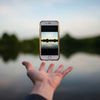Photographing Electronics (PCBoards)
Sep 19, 2014 10:42:45 #
I am beginning to research purchasing a camera and lens that will be able to photograph PCBs so that markings on the ICs are readable. For this to be accomplished I will need to be able to zoom into one section in order to read the sometimes faint markings on the components. But the entire assembly will need to be photographed. Right now, the largest is probably 8"x10"
I went to a Photo store and they led me towards a Nikon D7100 with a 40mm Macro lens.
I was just wondering if this is my best option or if there is a lower priced option that is still viable.
I went to a Photo store and they led me towards a Nikon D7100 with a 40mm Macro lens.
I was just wondering if this is my best option or if there is a lower priced option that is still viable.

Sep 19, 2014 11:01:56 #
The D7100 is a great camera. Rather than the 40mm macro lens I would suggest the Nikon 105 f2.8 macro lens as it will be more of an all around lens for you.
Dennis
Dennis
Sep 19, 2014 11:06:10 #
lynnew wrote:
I am beginning to research purchasing a camera and... (show quote)
I find that this can be done with most of todays smart phone cameras zoomed in on a PC. Don't get me wrong the D7100 is an amazing camera but if this is the primary or only use, it is way overkill. Go to a Camera store (Costco, Target, Bestbuy will do) and shoot the small print of some product on the shelf. Then put it in preview and zoom in. If you can read the text on the LCD it will be even better on a computer monitor.
Sep 19, 2014 11:13:30 #
Thanks for your input!
Right now I have a Nikon Coolpix and the customer is not happy with the resolution, which is why I started looking at something other than a point and shoot.
The point and shoot worked if I was only taking a photo or a small area, but as soon as I went to a bigger area it started getting grainy.
Right now I have a Nikon Coolpix and the customer is not happy with the resolution, which is why I started looking at something other than a point and shoot.
The point and shoot worked if I was only taking a photo or a small area, but as soon as I went to a bigger area it started getting grainy.
Sep 19, 2014 11:20:19 #
Big Bill
Loc: Phoenix, AZ
If you get a DSLR (which one makes little to no difference for this work), you will want a true macro lens, not one that merely focuses close.
The reason is that a real macro lens has a flat field of view (the area in focus is in focus across a flat field), as opposed to a regular lens, whose field of focus is a section of a sphere.
This is so that the entire PCB will be in focus.
The reason is that a real macro lens has a flat field of view (the area in focus is in focus across a flat field), as opposed to a regular lens, whose field of focus is a section of a sphere.
This is so that the entire PCB will be in focus.
Sep 19, 2014 11:28:31 #
Ok, first off you need to set your camera, regardless of what it is, to the center of the board AND on a perpendicular axis. Anything else short of that will not improve your result.
Your setup is the problem, not the camera/lens combination.
Your setup is the problem, not the camera/lens combination.
Sep 19, 2014 11:30:00 #
dennis2146 wrote:
The D7100 is a great camera. Rather than the 40mm macro lens I would suggest the Nikon 105 f2.8 macro lens as it will be more of an all around lens for you.
Dennis
Dennis
I don't agree with this at all. The 40mm is perfectly fine for non-critter macro work, and the 40mm is closer to the 50mm view that is typically designated as "all around"
105mm on a 7100 is a telephone and not really an all-around lens.
Sep 19, 2014 11:30:47 #
Thanks Big Bill. The camera shop quoted me a 40mm macro lens. I am assuming that is what you mean by a real macro lens as opposed to macro that is driven by the camera software as a point and shoot is.
Sep 19, 2014 11:33:23 #
I agree that this photo is not necessarily the best and I will be retraining the technician to use the tripod that I bought but she has refused to use. But that's another story!
Sep 19, 2014 11:35:06 #
lynnew wrote:
I agree that this photo is not necessarily the best and I will be retraining the technician to use the tripod that I bought but she has refused to use. But that's another story!
The 40mm is a real macro lens. See below, shot on a D7000. It's 1:1 true Macro.

Sep 19, 2014 11:40:32 #
Sep 19, 2014 11:44:23 #
lynnew wrote:
Wow!
You probably do not need the 7100 though, as other posters have said. You could do this with a D3100 and have plenty of resolution. Are you using a tripod or shooting hand held? Even the 1 series cameras would probably be good choices.
Sep 19, 2014 11:56:48 #
Stef C wrote:
I don't agree with this at all. The 40mm is perfectly fine for non-critter macro work, and the 40mm is closer to the 50mm view that is typically designated as "all around"
105mm on a 7100 is a telephone and not really an all-around lens.
105mm on a 7100 is a telephone and not really an all-around lens.
My suggestion of the 105 was not so much for an all around lens for everything such as the 50mm lens. I meant it as an all around macro lens, not only for his flat board work but also for macro work on insects etc. it would also work as a medium telephoto lens as well as a longer portrait lens. There are many uses for a 105 f2.8.
Dennis
Sep 19, 2014 12:03:52 #
lynnew wrote:
You have a whole lot to train her for.I agree that this photo is not necessarily the best and I will be retraining the technician to use the tripod that I bought but she has refused to use. But that's another story!
1) The camera should be oriented differently. If the rectangle is horizontal, the camera should be used in portrait mode. If vertical the camera should be in landscape.
2) A mid range tele of at least 150mm is a must and the distance of at least four feet. I would not touch that with a less than a 150mm and likely would use a 200mm.
3) light must be difuse so that there is no sharp shadows
4) focusing must reflect the flat surface, meaning that it is not dead on center but slightly off
5) dof must cover all the extreme as a board is 3D object, not a flat one.
Why:
1) by using the reverse camera orientation you use only the center of the lens, avoiding some of the lens distortion
2) the longer the lens the less distortion
3) no explanation necessary
4) the focus plane is a spherical plane you use the 2D model since you want the maximal resolution at that level (to read the serial or part #)
5) no explanation necessary
Oh, if your tech does not follow your instructions? Fire her ass.
The 'normal' tendency is to fill the sensor from corner to corner. This is the worst mistake one can make.
Sep 19, 2014 12:06:07 #
My micro four thirds camera with kit lens and extension tubes can photograph boards down to the IC level, with just slightly better than 1:1 macro. In other words, a 14 pin gull wing SOIC would just about fill the frame.
If you want to reply, then register here. Registration is free and your account is created instantly, so you can post right away.




